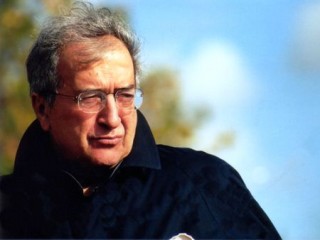
Luciano Berio biography
Date of birth : 1925-10-24
Date of death : 2003-05-27
Birthplace : Oneglia, Italy
Nationality : Italian
Category : Arts and Entertainment
Last modified : 2011-09-14
Credited as : opera composer, Sinfonia for voices, Sequenza
0 votes so far
Berio was born in 1925 in Oneglia, a town on Italy's northwest Ligurian coast. Both his father and grandfather were accomplished musicians, and Berio was initially trained by the latter as a youngster. He planned to become a pianist, but injured his hand while serving in the Italian Army during the final days of World War II. After the war's end, he studied composition at the Milan Conservatory, where he met his first wife, the American singer Cathy Berberian. After their 1950 marriage, they began traveling to New York City often, and there Berio came to know the Italian composer Luigi Dallapiccola, and was influenced by Dallapiccola's atonal style. One of Berio's first works was 1953's Chamber Music, a vocal piece with clarinet, cello, and harp based on the writings of Irish author James Joyce, which he wrote for Berberian to perform. Berio and Berberian later welcomed the birth of their daughter. During the 1950s, Berio became deeply involved in European avant garde music. After 1955, he ran a Milan studio for electronic music with Italian composer Bruno Maderna, whom he knew through summers spent at an academy for modernist composers and musicians in Darmstadt, West Germany. Some of Berio's most complex works came out of this era, including Tempi Concertati (1958-59) for flute, violin, two pianos and four instrumental groups. At Darmstadt he also came to know Pierre Boulez, Karlheinz Stockhausen, and other leading names in European music, and Stockhausen's daring electronica compositions were particularly influential on the direction of Berio's work. In 1958 he debuted what became "one of the early classics of tape music," according to Griffiths, Thema (Omaggio a Joyce), another work drawn from the Irish writer's free form prose. That year, the first in Berio's important "Sequenza" series was introduced as well, which were complex works for one instrument that showcased the history, style, and mood of each, beginning with the flute.
Berio spent a much of the 1960s living and working in the United States. He taught at Mills College in California in the early 1960s, where his students included future composer Steve Reich and Grateful Dead bassist Phil Lesh. After 1964 and the end of his first marriage, Berio lived in New York City with his second wife, Susan Oyama, a union that produced a son and daughter. For a number of years he was a professor of composition at the esteemed Juilliard School, and founded its Juilliard Ensemble, which performed many of his works under his baton. Over the years he increasingly drew from the pantheon of musical forms of the past, including Giuseppe Verdi's operas, the early modernist works from Igor Stravinsky, and even Gustav Mahler's romantic symphonies. He continued to find inspiration in literary works as well, and his Sinfonia for orchestra and vocal octet (1968-9) incorporated Mahler's "'Resurrection" Symphony as well as the words of dramatist Samuel Beckett. "The result was Mahler transformed," Mark Swed noted in the Los Angeles Times, "and a work that was credited with kicking off the contemporary genres of post "Modernism and New Romanticism."
Berio's first full scale opera, simply titled Opera, debuted with the Santa Fe Opera in 1970. In 1971, he and Oyama divorced. After 1972, he lived and worked primarily in Italy, settling in a town near Siena called Radicondoli. He married Talia Pecker in the mid 1970s; they had two sons. His sole excursion was a few years in the 1970s spent running Boulez's computer music institute in Paris, France, but in 1980 Berio established his own electronic studio in Florence, which he named Tempo Reale. His most important works of the decade are considered Una vera storia ("A True Story"), which had its premiere in Florence in 1982, and Un re in Ascolto ("A King Listens"), which debuted at the prestigious Salzburg Festival in Austria in 1984. Both operas were collaborations between Berio and Italy's foremost living writer of the time, Italo Calvino.
After 2000 Berio served as president of the National Academy of St. Cecilia, a venerable Roman institution that includes an orchestra, library, school, and array of other musical organizations. He was also a frequent guest conductor with the Los Angeles Philharmonic for a number of years, and was working on an orchestration for a Monteverdi opera commissioned by the Los Angeles Opera artistic director Placido Domingo just before his death in 2003. The famed tenor sometimes teased the avant gardist about his style. "'Luciano,'" Domingo recalled in the Los Angeles Times article, "'write for me some melodic music that I can sing,' I would say to him. And he would reply, 'Placido, everything I write sounds melodic to me.'"
Berio died on May 27, 2003; he was 77. He is survived by his third wife, Talia Pecker Berio; daughters Cristina and Marina; sons Stefano, Dani, and Yoni; four grandchildren, and one great grandchild.
















